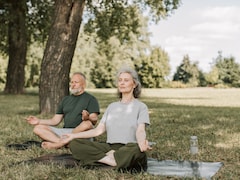Here are six effective lung-boosting exercises that can help you breathe more easily and strengthen your respiratory system, making it more resilient to pollution's effects.

In the face of rising pollution levels, breathing easy has become a challenge, especially in urban areas where poor air quality can affect respiratory health. Heavy breathing, fatigue, and reduced lung function are common complaints for people exposed to polluted environments daily. While you can't always control the air around you, you can improve your lung capacity and overall respiratory health through targeted exercises. Here are six effective lung-boosting exercises that can help you breathe more easily and strengthen your respiratory system, making it more resilient to pollution's effects.
1. Diaphragmatic breathing to activate core muscles
Diaphragmatic breathing, or "belly breathing," is a foundational technique that helps to fully engage your diaphragm, which increases lung capacity and improves oxygen flow. To perform it, place one hand on your abdomen and inhale deeply through your nose, allowing your stomach to expand. Exhale slowly through your mouth while tightening your abdominal muscles. Practicing this for 5–10 minutes daily helps reinforce deep breathing and relieves shallow, chest-only breaths caused by air pollution.
2. Pursed-lip breathing to improve oxygen intake
Pursed-lip breathing is a simple yet powerful way to maintain open airways for a longer time, making each breath more effective. Start by inhaling slowly through your nose, then exhale gently through pursed lips, as if blowing through a straw. This technique slows down the breathing rate, increases oxygenation, and reduces the sensation of breathlessness. It's especially useful for people who experience shortness of breath due to pollution or other respiratory irritants.
3. Rib-stretch breathing for expanding lung capacity
Rib-stretch breathing helps to stretch and expand your intercostal muscles, located between your ribs, allowing for greater lung expansion. Stand upright with your hands on your hips, inhale deeply through your nose to fill your lungs, and hold your breath for a few seconds. Then, slowly exhale. Repeat this process 5–10 times daily to increase the space your lungs can fill, improving both lung function and resilience against the effects of pollution.
4. Deep coughing to clear airways
Coughing isn't just a symptom of pollution exposure; it can also be a productive way to clear your airways. Deep coughing exercises help expel mucus, pollutants, and irritants from your respiratory system. To do this exercise, sit down, take a deep breath, and exhale with a strong cough from deep within your chest. This method not only helps clear mucus but also strengthens your lung muscles, enhancing your ability to handle pollutants.
5. Interval training for respiratory strength
Interval training, which involves alternating between high and low-intensity exercises, can significantly improve lung capacity and endurance. Try brisk walking or jogging for a minute, then slow down to a moderate pace for two minutes. Repeat this cycle for 15–20 minutes. By pushing your respiratory system to adapt to changing levels of intensity, interval training boosts lung strength and oxygen efficiency, helping your lungs manage polluted air more effectively.
6. Yoga breathing exercises for relaxation and lung health
Yoga incorporates many breathing techniques, or "pranayama," that enhance lung function, reduce stress, and improve overall respiratory health. Exercises such as "Nadi Shodhana" (alternate nostril breathing) help clear airways and promote balanced oxygen flow. Practicing these breathing techniques daily can alleviate the effects of pollution by promoting deeper, more controlled breathing, which oxygenates your body and eases the burden on your lungs.
7. Walking lunges for full-body and lung strength
Walking lunges, though a leg-strengthening exercise, also help expand your lung capacity by improving circulation and oxygen flow. To perform, take a step forward with one leg and lower your body until your knees are bent at a 90-degree angle. As you rise, inhale deeply, then exhale as you step forward with the other leg. This motion engages your core and stimulates deeper breathing, ultimately supporting respiratory resilience and lung health.
With increasing pollution impacting our respiratory health, keeping our lungs strong and resilient has become more essential than ever. These six exercises not only improve lung capacity and oxygen intake but also support overall respiratory wellness. By incorporating them into your daily routine, you can reduce the harmful effects of polluted air on your lungs, helping you breathe easier, feel stronger, and live healthier. Remember, while these exercises can enhance lung function, it's also crucial to minimise pollution exposure whenever possible, such as using masks and staying indoors during high pollution levels.
Disclaimer: This content including advice provides generic information only. It is in no way a substitute for a qualified medical opinion. Always consult a specialist or your own doctor for more information. NDTV does not claim responsibility for this information.
DoctorNDTV is the one stop site for all your health needs providing the most credible health information, health news and tips with expert advice on healthy living, diet plans, informative videos etc. You can get the most relevant and accurate info you need about health problems like diabetes, cancer, pregnancy, HIV and AIDS, weight loss and many other lifestyle diseases. We have a panel of over 350 experts who help us develop content by giving their valuable inputs and bringing to us the latest in the world of healthcare.














